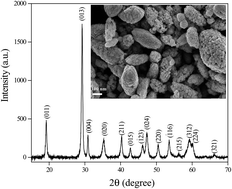SWCNT/BiVO4 composites as anode materials for supercapacitor application†
Abstract
In this report, we have systematically investigated the effect of SWCNTs on the electrochemical performance of BiVO4: a material not studied for energy storage. Loading of 20 wt% SWCNTs with BiVO4 exhibited the highest specific capacitance (395 F g−1) and up to 88% coulombic efficiency was obtained over 200 cycles of charge–discharge for this composite.


 Please wait while we load your content...
Please wait while we load your content...